Apple Cider Glazed Chicken Breast with Carrots
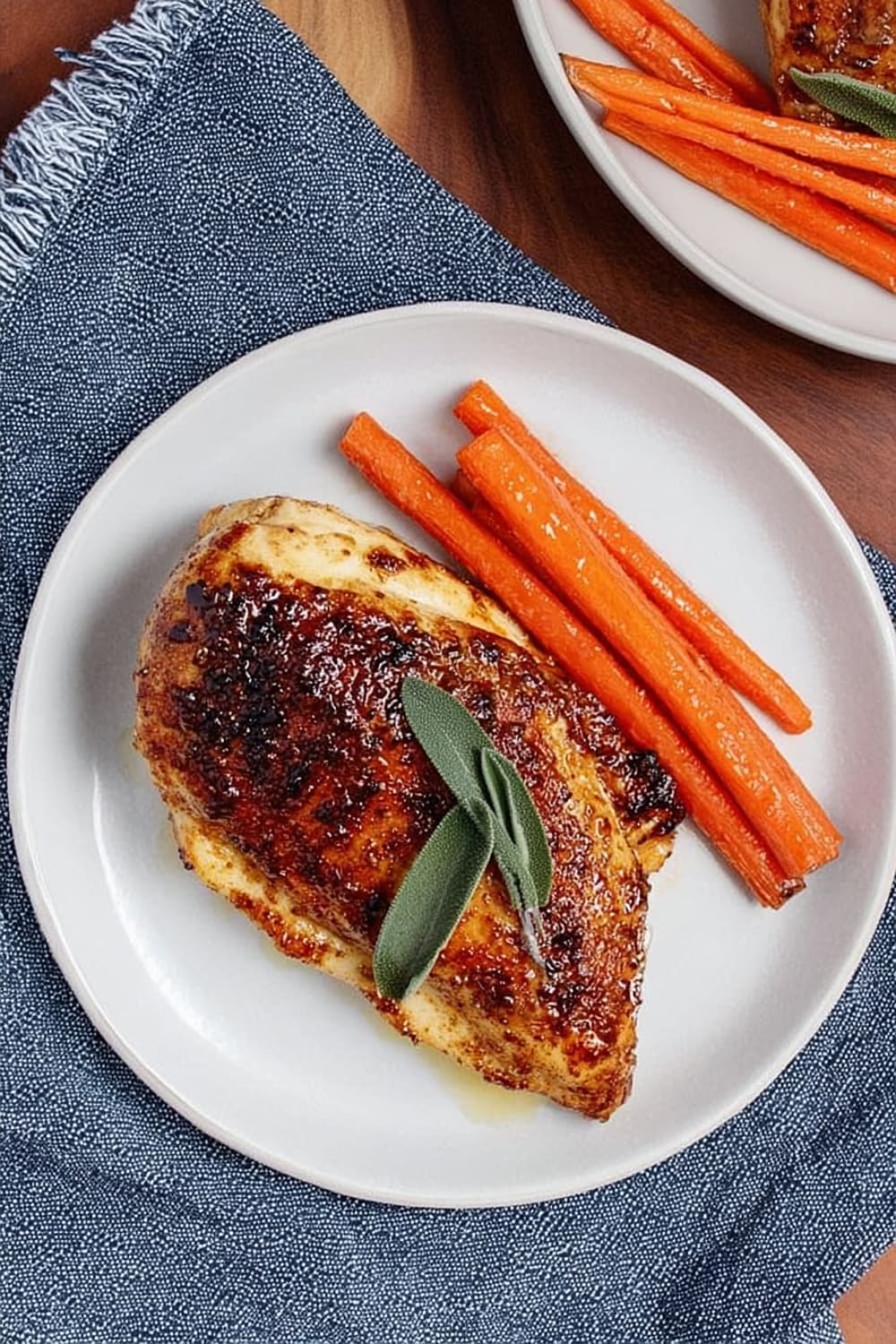
This apple cider glazed chicken breast is basically the food equivalent of a warm hug on a crisp fall day, except it makes you look like you actually know what you’re doing in the kitchen.
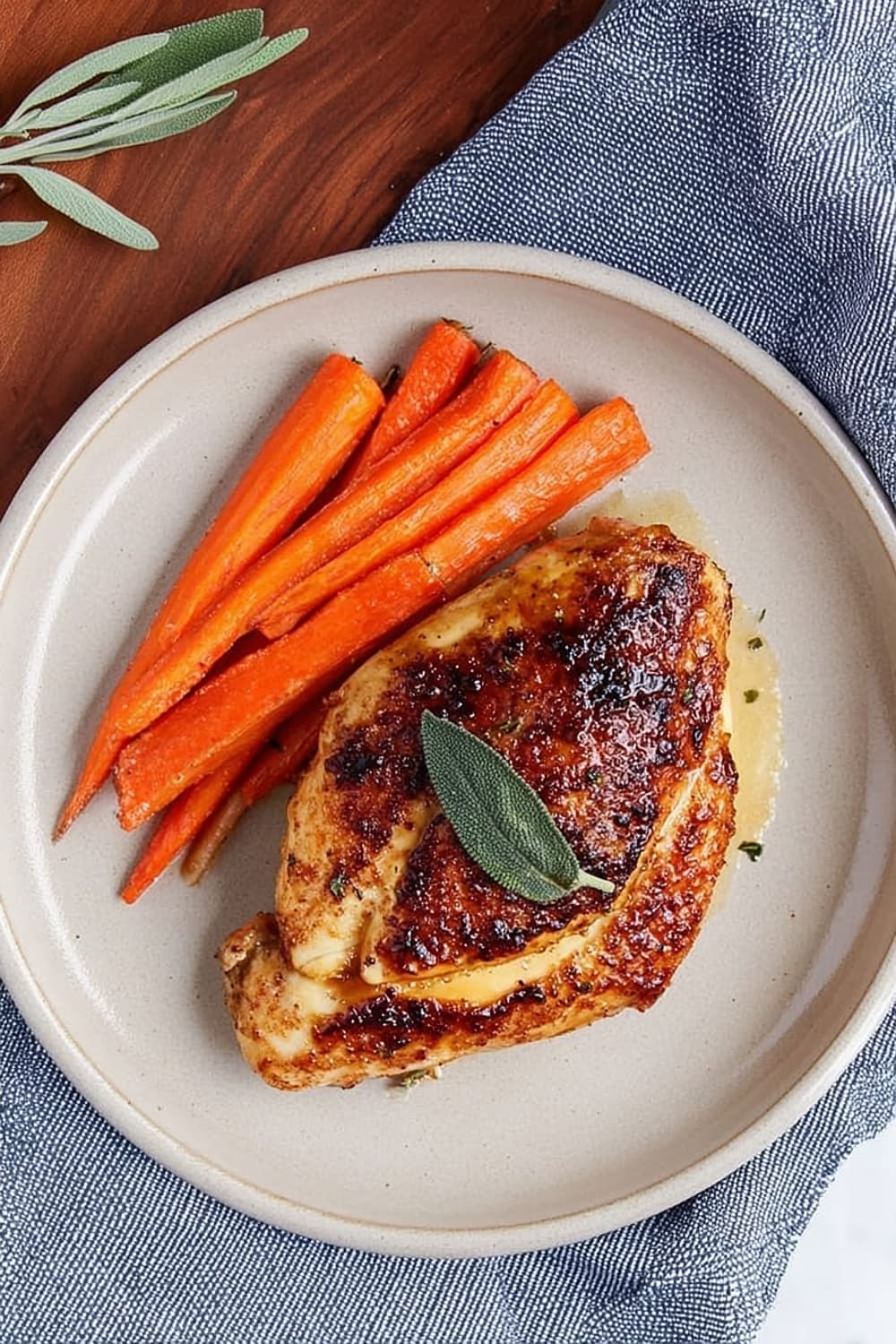
The sweet-tangy glaze transforms ordinary chicken into something that’ll have your dinner guests asking for the recipe while secretly wondering if you’ve been hiding culinary superpowers this whole time.
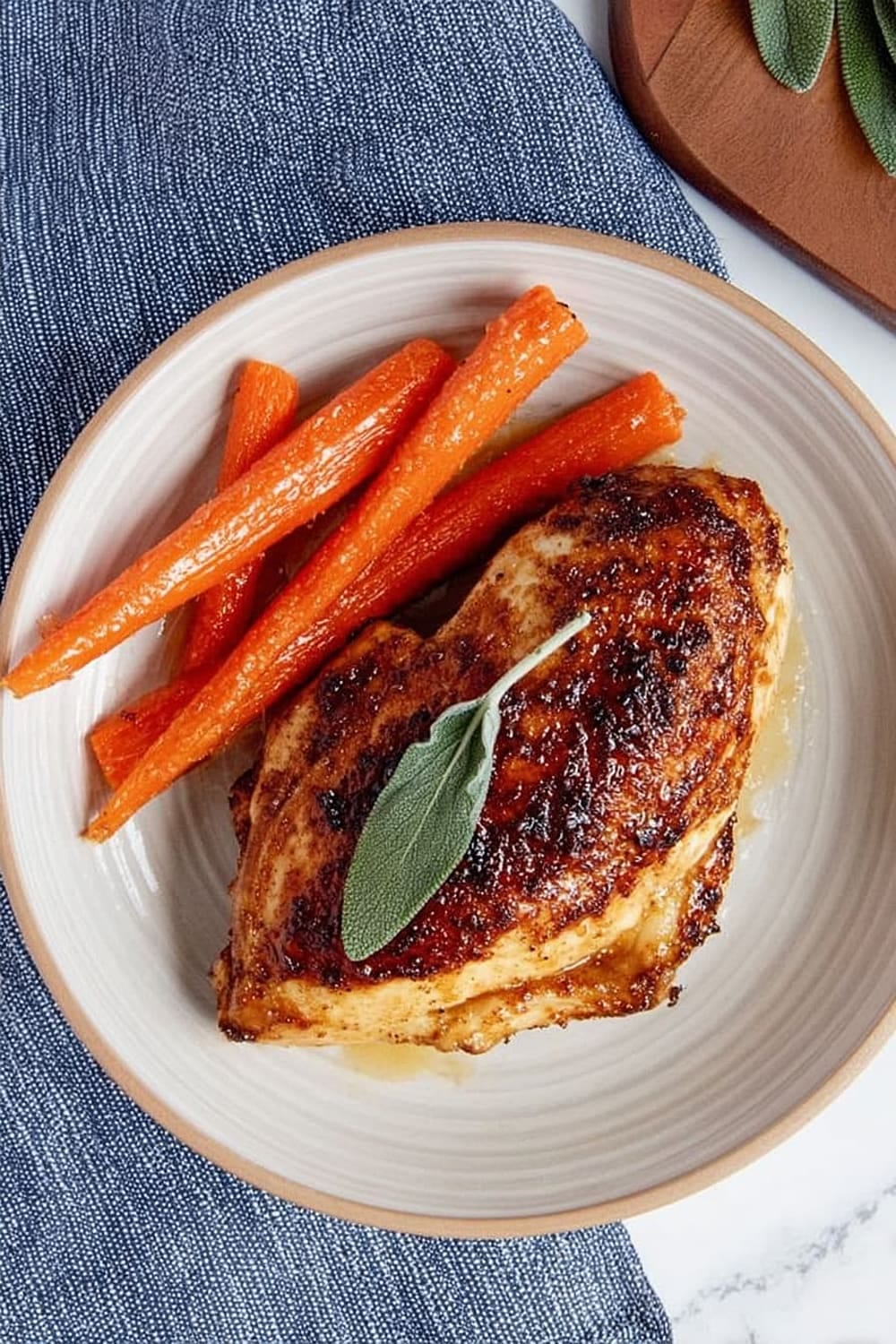
That gorgeous golden skin crackling in the cast iron skillet while the apple cider reduces to liquid gold is the kind of kitchen magic that makes you feel like a food network star.
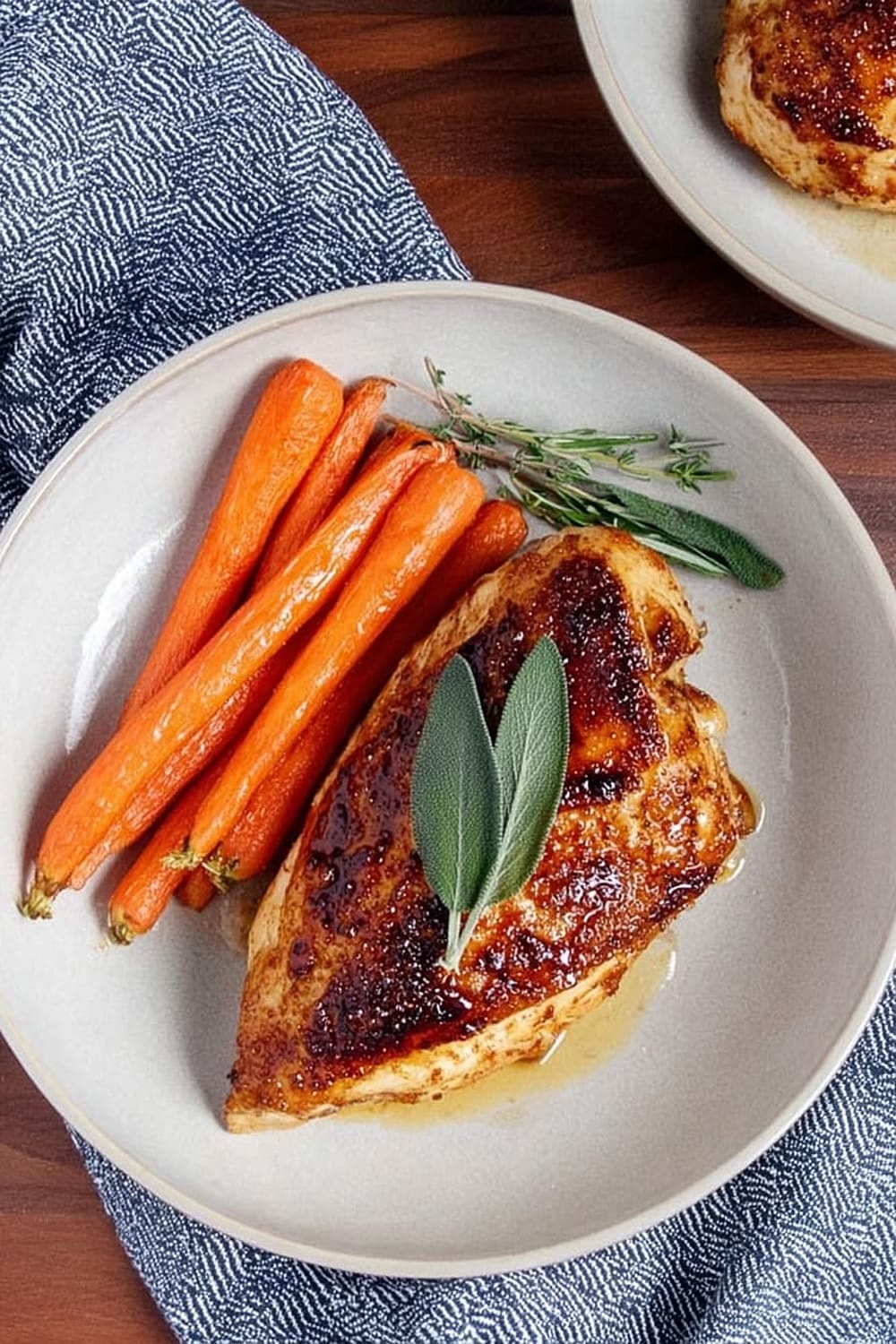
The best part is watching that simple apple cider transform from a basic beverage into a glossy, caramelized glaze that clings to every piece of tender chicken and sweet carrot.
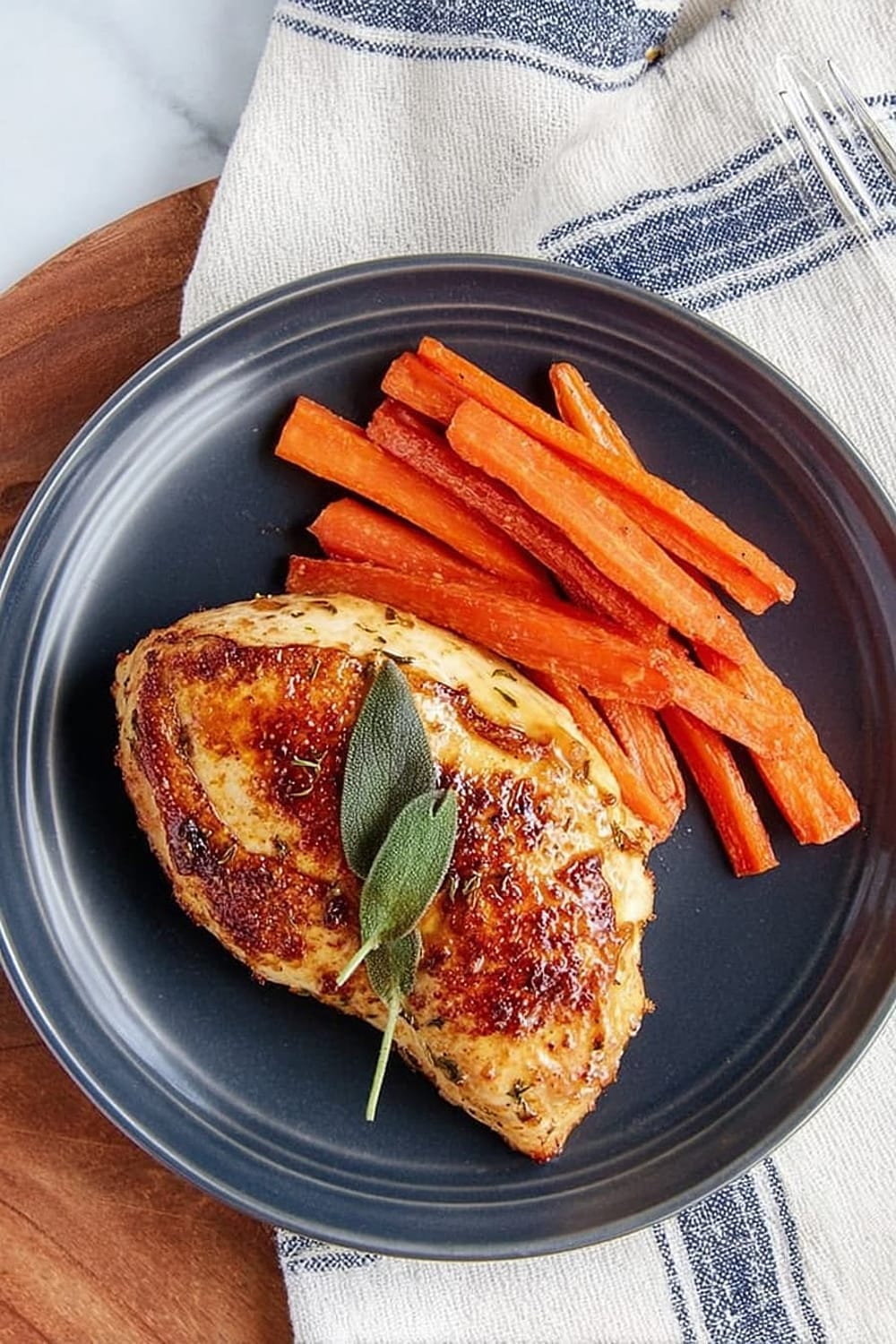
This recipe is proof that sometimes the most impressive dishes come from the simplest ingredients – just chicken, apple cider, and a little patience for that marinade to work its magic.
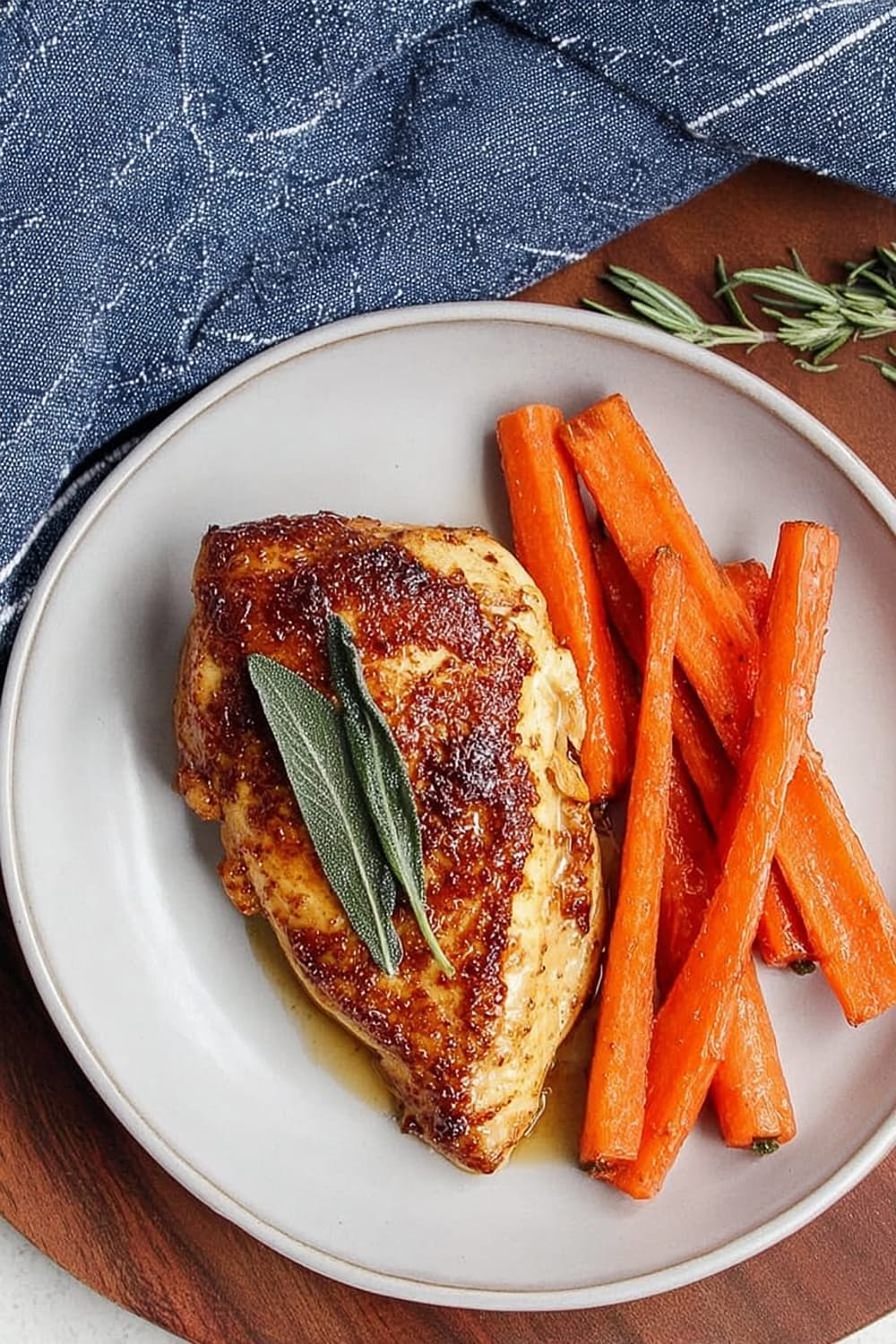
Fair warning: making this will result in people assuming you’re some kind of cooking genius, when really you just followed directions and didn’t burn anything.
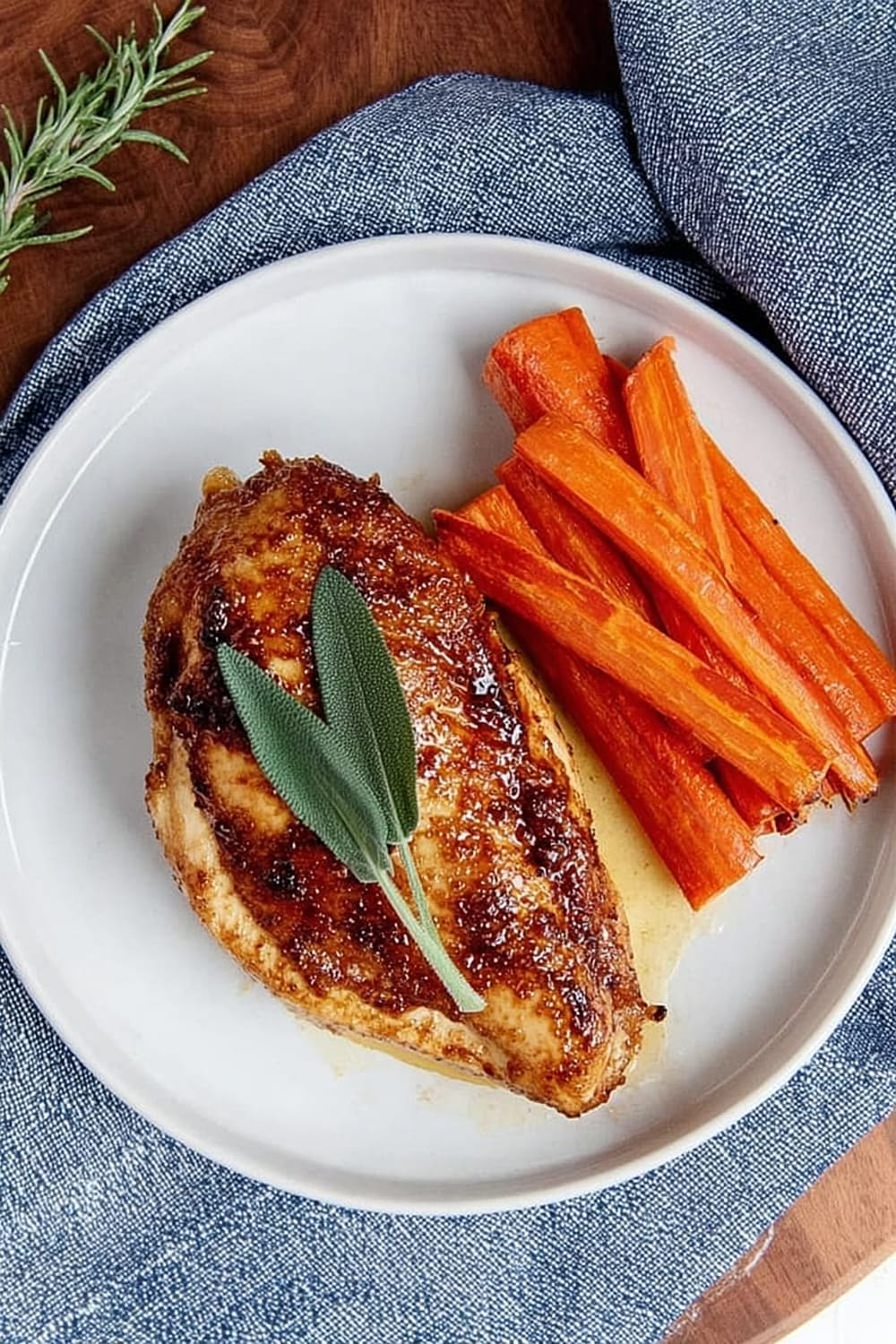
Ingredients
For the Chicken and Marinade
- 2 boneless skin-on chicken breasts
- 2 cups apple cider (the good stuff, not from concentrate if possible)
- 4 whole peppercorns
- 2 small bunches fresh sage, torn and chopped
- 1 /2 teaspoon salt
For Cooking
- 2 tablespoons olive oil (extra virgin for best flavor)
- Salt and pepper, to taste
For the Glazed Carrots
- 4 carrots, peeled and sliced
- 1 tablespoon butter (grass-fed butter adds richness)
Instructions
Preparation
- 1 Remove the tenderloin from each chicken breast if still attached – it’s that extra piece that looks like a chicken finger. This helps the chicken cook more evenly and faster. Pro tip: freeze those tenderloins for soup or make chicken fingers with them later.
- 2 In a large bowl or shallow dish, combine the chicken, apple cider, peppercorns, chopped sage, and 1/2 teaspoon salt. Cover and marinate in the refrigerator for a minimum of 4 hours (overnight is even better for maximum flavor penetration).
Cooking the Chicken
- 3 After marinating, remove the chicken from the marinade and pat completely dry with paper towels – this is crucial for achieving that golden-brown skin. Save every drop of that marinade; it’s about to become liquid gold.
- 4 Heat 2 tablespoons olive oil in a large cast iron skillet or heavy-bottomed pan over medium-high heat until the oil shimmers. Avoid non-stick pans here – you want that beautiful browning action that only happens with proper heat conduction.
- 5 Season the dried chicken generously with salt and pepper, then place skin-side down in the hot oil. Cook without moving for 4-5 minutes until the skin is golden brown and releases easily from the pan, then flip and brown the other side for another 3-4 minutes.
Preparing the Carrots
- 6 While the chicken browns, peel and dice the carrots into uniform pieces for even cooking. Place them in a microwave-safe bowl, cover tightly with plastic wrap, and microwave for 1 minute to jumpstart the cooking process.
Creating the Glaze
- 7 Remove the peppercorns and sage pieces from the reserved apple cider marinade, then pour the liquid over the browned chicken in the skillet. Adjust heat to maintain a gentle simmer – you want bubbling but not a rolling boil.
- 8 Continue simmering until the chicken reaches an internal temperature of 165°F (74°C) when checked with an instant-read thermometer inserted into the thickest part. This usually takes 8-12 minutes depending on thickness.
Finishing the Dish
- 9 Remove the cooked chicken from the pan and set aside to rest. Turn the heat to high and let the apple cider reduce to a thick, glossy glaze that coats the back of a spoon – this takes about 3-5 minutes of vigorous bubbling.
- 10 Add the pre-cooked carrots to the reduced glaze and sauté for 3-4 minutes until they’re crisp-tender and beautifully coated. The carrots should still have a slight bite to them.
- 11 Remove the pan from heat and stir in 1 tablespoon butter to give the glaze a restaurant-quality shine and richness. The butter should melt and create a silky finish.
- 12 Brush any remaining glaze over the rested chicken breasts and serve immediately alongside the glazed carrots while everything is still hot and glossy.
Recommended Equipment and Kitchen Tools
Essential Tools (for best results)
- Cast iron skillet – The superior heat retention and distribution creates that perfect golden-brown skin that non-stick pans simply can’t achieve. A 10-12 inch size works perfectly for two chicken breasts
- Instant-read thermometer – Takes the guesswork out of doneness and prevents overcooking expensive chicken breasts. Digital models give readings in under 3 seconds
- Large mixing bowl or shallow dish – For marinating the chicken comfortably. Glass or stainless steel won’t absorb flavors like plastic might
Helpful Upgrades
- Kitchen scale – For precise measurements if you’re scaling the recipe up or down, especially helpful when cooking for larger groups
- Microplane grater – Perfect for zesting citrus if you want to add lemon zest to brighten the glaze
- Silicone spatula – Heat-resistant and flexible for stirring the reducing glaze without scratching your cookware
Nice-to-Have Options
Mandoline slicer – Creates perfectly uniform carrot slices for even cooking and professional presentation
Fine-mesh strainer – Useful if you want to strain the reduced glaze for an ultra-smooth finish, though it’s not necessary for home cooking
Remember, these are suggestions to make your cooking experience smoother and more enjoyable – you can absolutely make this recipe successfully with basic kitchen tools you already own.
Recipe Variations and Dietary Modifications
Protein Variations
- Pork tenderloin → Use the same marinade and cooking method, but reduce cooking time to 12-15 minutes total
- Chicken thighs → Increase cooking time to 20-25 minutes for bone-in thighs, skin-side down first for extra crispiness
- Turkey breast → Slice into cutlets and reduce cooking time to 6-8 minutes per side
Flavor Variations
- Cranberry-orange twist → Replace apple cider with cranberry juice and add orange zest to the marinade
- Maple-bourbon glaze → Add 2 tablespoons maple syrup and 1 tablespoon bourbon to the reducing liquid
- Herb variations → Substitute sage with fresh thyme, rosemary, or tarragon for different flavor profiles
Vegetable Swaps
- Root vegetable medley → Replace carrots with parsnips, turnips, or sweet potatoes cut into similar sizes
- Brussels sprouts → Halved and added during the last 5 minutes of glazing for a fall-inspired twist
- Apple additions → Add sliced apples during the last 3 minutes for extra autumn flavor
Seasonal Adaptations
- Summer version → Use peach nectar instead of apple cider and pair with zucchini and yellow squash
- Winter comfort → Add diced butternut squash and dried cranberries to the carrot mixture
- Spring fresh → Include baby carrots and fresh peas added in the final 2 minutes
Nutritional Information and Health Benefits
Key Nutritional Highlights
This recipe provides approximately 320-350 calories per serving, with the majority coming from high-quality lean protein. Each serving delivers about 35-40 grams of protein from the chicken breast, making it excellent for muscle maintenance and satiety. The apple cider contributes natural sugars and 15-20 grams of carbohydrates, while the carrots add fiber and essential vitamins with minimal calories.
Health Benefits of Main Ingredients
Chicken breast is one of the leanest protein sources available, providing all essential amino acids while being naturally low in saturated fat. Apple cider contains beneficial plant compounds called polyphenols, which have antioxidant properties and may support heart health. The natural sugars in apple cider are balanced by its potassium content, which supports healthy blood pressure. Fresh sage is rich in antioxidants and has been traditionally used for its anti-inflammatory properties. Carrots are loaded with beta-carotene, which converts to vitamin A in the body, supporting eye health and immune function.
Dietary Considerations
This recipe is naturally gluten-free and dairy-free (except for the small amount of butter, which can be substituted). It’s also low in sodium when you control the added salt, making it suitable for heart-healthy eating plans. The dish provides a good balance of protein and vegetables, fitting well into Mediterranean-style or whole-food eating patterns.
Smart Swaps and Ingredient Substitutions
Common Substitutions:
- Apple cider → Apple juice mixed with 1 tablespoon apple cider vinegar for tang, or white grape juice for a milder flavor
- Fresh sage → Dried sage (use 1 teaspoon instead of 2 bunches), or substitute with fresh thyme or rosemary
- Whole peppercorns → 1/4 teaspoon ground black pepper mixed into the marinade
- Butter → Olive oil or vegan butter for dairy-free version
Budget-Friendly Swaps:
- Boneless chicken breasts → Bone-in chicken thighs (more affordable and actually more flavorful, just increase cooking time)
- Organic apple cider → Regular apple juice from concentrate works fine for the glaze
- Fresh herbs → Dried herbs using the 3:1 ratio (3 parts fresh = 1 part dried)
Pantry Emergency Substitutions:
- Fresh carrots → Frozen carrot coins (skip the microwave step and add directly to the glaze)
- Apple cider → Chicken broth mixed with 2 tablespoons honey and 1 tablespoon vinegar
- Olive oil → Vegetable oil or canola oil for cooking
Pro Tips for Substitutions:
- When using dried herbs instead of fresh, add them earlier in the cooking process to allow their flavors to bloom
- If substituting apple juice for cider, add a splash of lemon juice to brighten the flavor profile
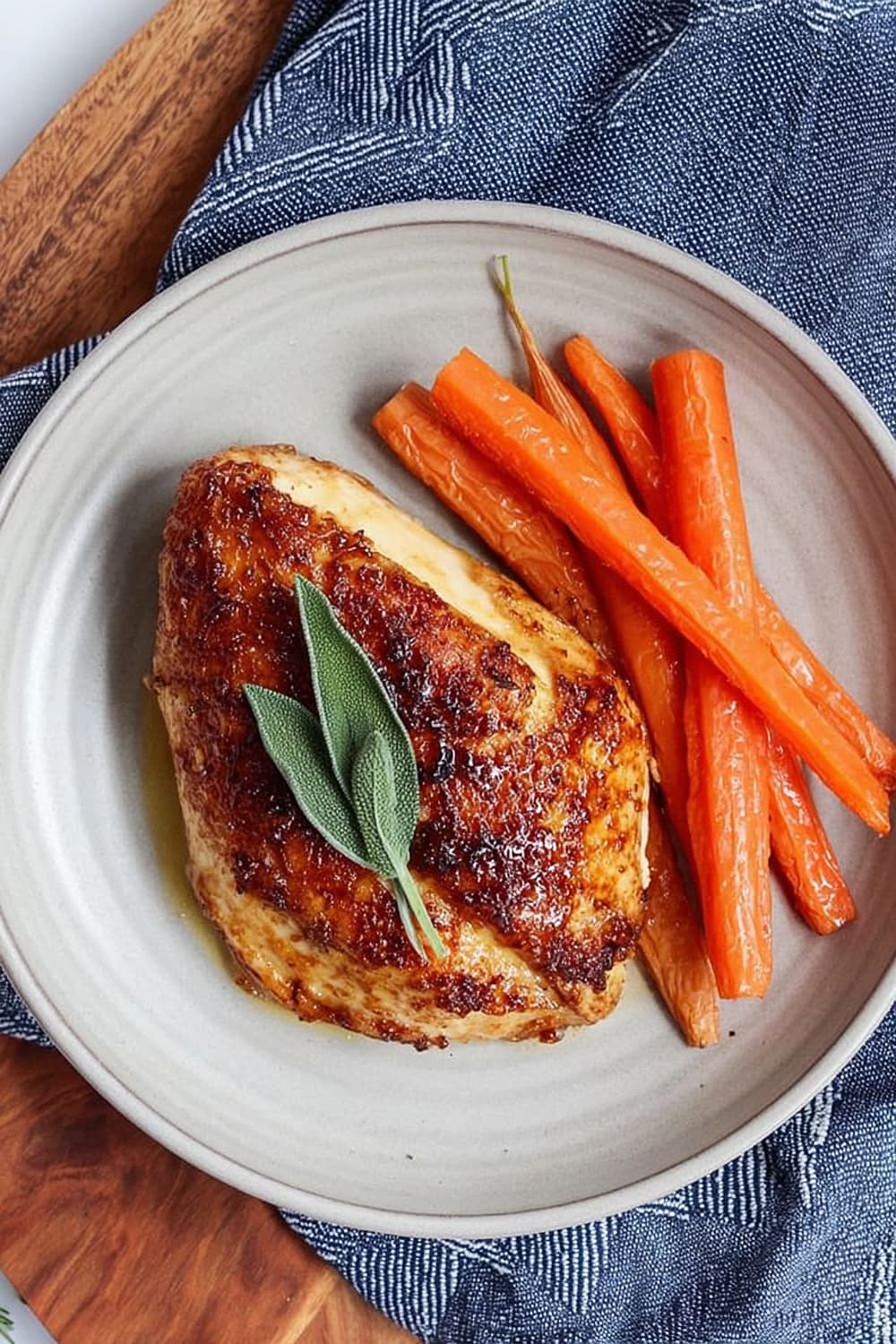
Make It Diabetes-Friendly
Natural Sugar Modifications:
- Reduce apple cider → Use 1 cup apple cider mixed with 1 cup low-sodium chicken broth to cut natural sugars in half
- Add flavor enhancers → Include extra herbs, garlic, and onion powder to compensate for reduced sweetness
- Boost umami → Add 1 tablespoon low-sodium soy sauce or Worcestershire sauce to the marinade for depth
Carb-Conscious Vegetable Swaps:
- Replace carrots → Green beans, asparagus, or zucchini for lower carb content
- Add volume → Include cauliflower florets or broccoli to increase portion size without adding carbs
- Leafy additions → Finish with fresh spinach or arugula for extra nutrients and fiber
Portion & Blood Sugar Tips:
- Ideal serving size → 4-5 oz chicken with 1/2 cup vegetables provides about 8-10 grams total carbs
- Protein pairing → The high protein content helps slow sugar absorption from the apple cider
- Fiber boost → Serve over cauliflower rice or alongside a green salad to further moderate blood sugar impact
Total Carb Reduction: These modifications reduce carbs from approximately 18-20 grams to 8-12 grams per serving while maintaining flavor.
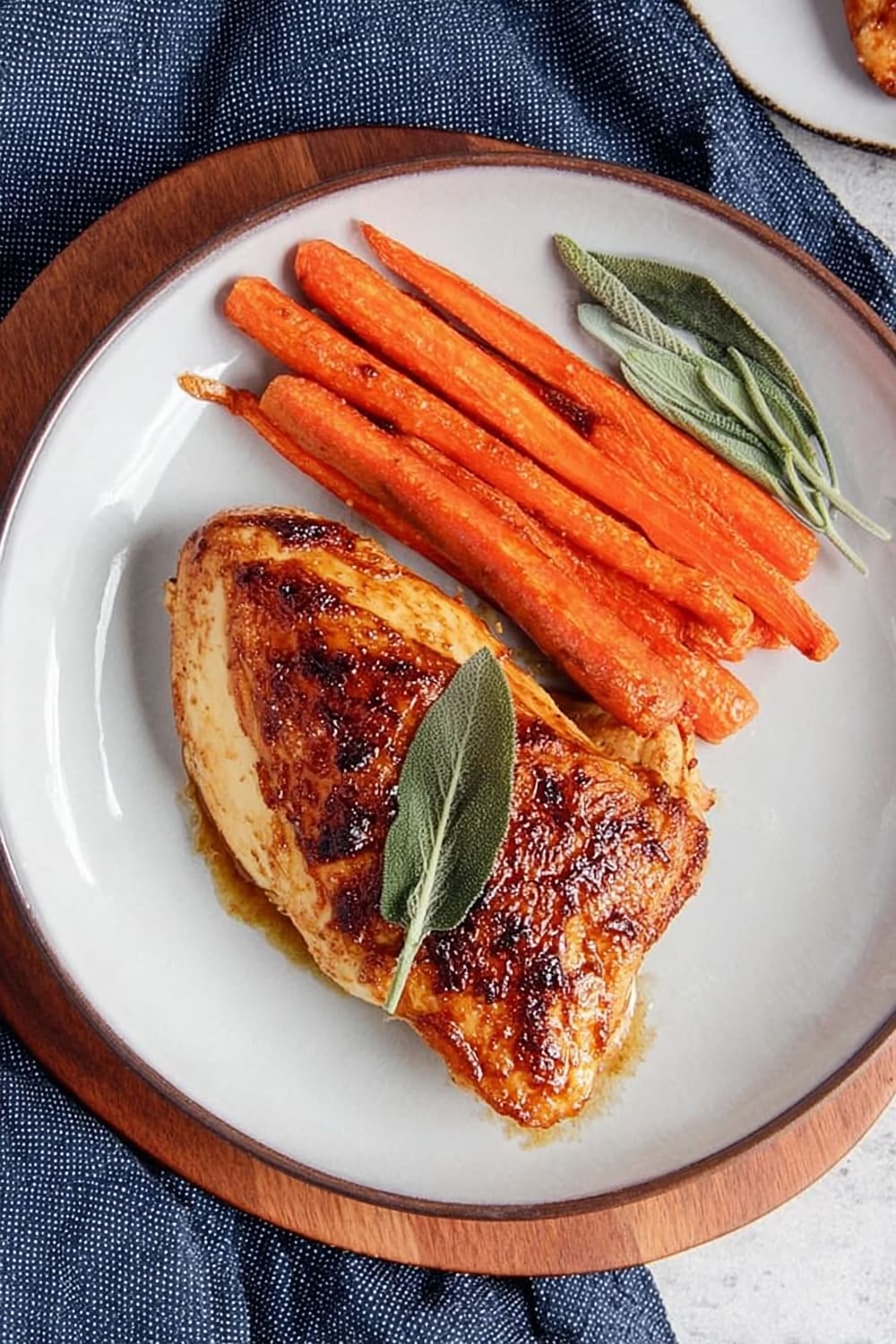
Perfect Pairing Suggestions
Beverage Pairings
A Pinot Grigio or Sauvignon Blanc complements the apple and herb flavors beautifully without overwhelming the delicate chicken. For red wine lovers, a light Pinot Noir echoes the autumn flavors perfectly. Hard apple cider creates a delightful flavor echo, while sparkling apple juice with fresh herbs makes an elegant non-alcoholic option. Herbal teas like chamomile or sage tea work wonderfully for a cozy dinner setting.
Side Dish Recommendations
Wild rice pilaf or quinoa adds nutty flavors that complement the sweet glaze without competing. Roasted Brussels sprouts with bacon provide a savory contrast to the sweet elements. Garlic mashed cauliflower offers comfort food appeal with fewer carbs than traditional potatoes. Arugula salad with dried cranberries and toasted walnuts creates textural contrast and seasonal harmony.
Complete Meal Ideas
Start with a butternut squash soup to embrace the autumn theme, then serve this chicken as the main course with roasted root vegetables and dinner rolls. For dessert, apple crisp or pear tart continues the orchard fruit theme. This combination works beautifully for Thanksgiving dinner, date nights, or Sunday family dinners.
Occasion Suggestions
This recipe shines for romantic dinners for two, holiday entertaining, or meal prep for the week ahead. The elegant presentation makes it perfect for dinner parties, while the simple preparation keeps it accessible for weeknight cooking. It’s particularly stunning for fall celebrations and harvest-themed gatherings.
Pro Tips and Troubleshooting
Professional Techniques
Always let your chicken come to room temperature for 15-20 minutes before cooking – this ensures even cooking throughout. When reducing the apple cider, resist the urge to stir constantly; let it bubble and concentrate naturally for the best flavor development. Rest the chicken for 5 minutes after cooking to allow juices to redistribute, ensuring every bite stays moist and flavorful.
Common Mistake Prevention
Don’t skip patting the chicken dry after marinating – moisture is the enemy of golden-brown skin. Avoid moving the chicken too early when searing; it will release naturally when properly browned. Never reduce the glaze over high heat without watching carefully – it can go from perfect to burnt in seconds.
Storage and Reheating
Store leftover chicken and vegetables separately in the refrigerator for up to 3 days. Reheat chicken in a 300°F (150°C) oven for 10-12 minutes to maintain moisture. The glaze can be gently rewarmed in a small saucepan with a splash of apple cider to restore its consistency.
Make-Ahead Strategy
Marinate the chicken up to 24 hours in advance for deeper flavor penetration. The entire dish can be prepared earlier in the day and reheated gently, though the skin won’t be quite as crispy. For meal prep, prepare components separately and combine when serving for best results.
This apple cider glazed chicken breast with carrots proves that sometimes the most memorable meals come from the simplest combinations – just quality ingredients, proper technique, and a little patience for that glaze to work its magic. Whether you’re cooking for a special someone or just treating yourself to something delicious, this recipe delivers restaurant-quality results with home-kitchen ease.